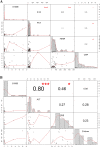Serum S100B protein as a marker of severity in Covid-19 patients
- PMID: 33122776
- PMCID: PMC7596559
- DOI: 10.1038/s41598-020-75618-0
Serum S100B protein as a marker of severity in Covid-19 patients
Abstract
SARS-CoV-2 infection shows a wide-ranging clinical severity, requiring prognostic markers. We focused on S100B, a calcium-binding protein present in biological fluids, being a reliable biomarker in disorders having inflammatory processes as common basis and RAGE as main receptor. Since Covid-19 is characterized by a potent inflammatory response also involving RAGE, we tested if S100B serum levels were related to disease severity. Serum samples (n = 74) were collected from hospitalized SARS-CoV-2 positive patients admitted to Covid center. Illness severity was established by admission clinical criteria and Covid risk score. Treatment protocols followed WHO guidelines available at the time. Circulating S100B was determined by ELISA assay. Statistical analysis used Pearson's χ2 test, t-Test, and ANOVA, ANCOVA, Linear Regression. S100B was detected in serum from Covid-19 patients, significantly correlating with disease severity as shown both by the level of intensity of care (p < 0.006) as well by the value of Covid score (Multiple R-squared: 0.3751); the correlation between Covid-Score and S100B was 0.61 (p < 0.01). S100B concentration was associated with inflammation markers (Ferritin, C-Reactive Protein, Procalcitonin), and organ damage markers (Alanine Aminotransferase, Creatinine). Serum S100B plays a role in Covid-19 and can represent a marker of clinical severity in Sars-CoV-2 infected patients.
Conflict of interest statement
The authors declare no competing interests.
Figures



References
-
- WHO. Clinical management of severe acute respiratory infection (SARI) when COVID-19 disease is suspected: interim guidance, 13 March 2020 [Online]. Available from: https://apps.who.int/iris/handle/10665/331446. Accessed 24 March 2002.
Publication types
MeSH terms
Substances
LinkOut - more resources
Full Text Sources
Medical
Research Materials
Miscellaneous

